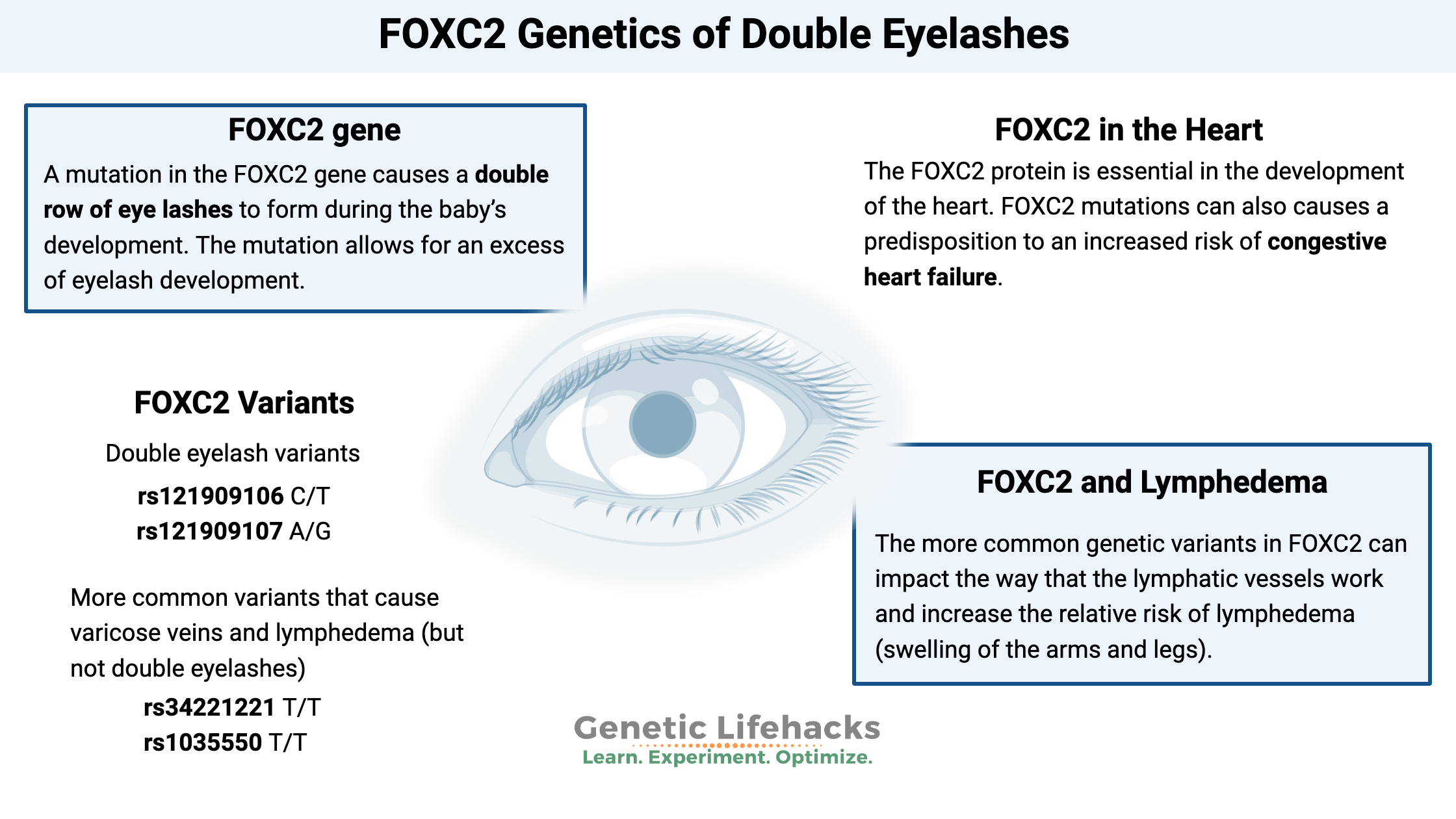Key takeaways:
~ Mutations in the FOXC2 gene can cause a double row of eyelashes – Elizabeth Taylor eyes.[article]
~ The FOXC2 gene is a transcription factor important during fetal development for the heart, kidneys, lymphatic system, and eyelashes.
~ Mutations in FOXC2 can also cause lower limb lymphedema (puffiness) and congestive heart failure.
~ You can check your 23andMe, AncestryDNA, etc. data for FOXC2 variants and mutations.
Distichiasis: Double Eyelashes
Being born with double eyelashes is caused by a mutation in the FOXC2 gene.
The FOX (forkhead box) family of genes codes for a type of protein known as a transcription factor. This type of protein turns on and off genes during development as well as during cellular replication.
The FOXC2 gene turns genes on and off during prenatal development.
Specifically, the early development of the kidneys and the heart utilize FOXC2. It is particularly important for the development of the valves in the lymphatic system.[ref][ref]
So what do lymphatic valves and heart development have to do with double eyelashes?
Double Lashes (Elizabeth Taylor eyes):
The mutation in the FOXC2 gene causes a double row of lashes to form during the baby’s development. The mutation allows for an excess of eyelash development.
This mutation can also cause droopy or hooded eyelids and yellowish nails.
The double lash mutations are inherited in an autosomal dominant manner. This means that you only need one copy of the mutation to have the genetic condition. For double lashes, about 75% of the time the mutation is inherited from a parent, but for about a quarter of people, the mutation is de novo. De Novo mutations are ones that arise spontaneously in either the egg or sperm cell and the parents don’t have the mutation.
FOXC2 and the lymphatic system:
Additionally, the FOXC2 mutation causes a predisposition to lymphedema (swelling of the arms and legs) and an increased risk of congestive heart failure.[ref]
Sadly, the poster child of double lashes, Elizabeth Taylor, died of congestive heart failure.
Lymphedema-distichiasis is the syndrome characterized by lower-limb lymphedema and distichiasis, which is the medical term for aberrant eyelashes including double lashes. Lymphedema is the buildup of lymph fluid. In lymphedema-distichiasis syndrome, the lymph tends to collect in the legs usually by the teen years. [ref]
FOXC2 in tumors:
FOXC2 can be altered in tumors and, as a transcription factor, causes increased growth and metastasis. Essentially, in cancer, FOXC2 is often upregulated and causes progression. This is different than the mutation that causes double lashes.
FOXC2 in the heart:
In addition to being important in the formation of the lymph vessels, the FOXC2 protein is essential in the development of the heart. Animal studies show that deleting the FOXC2 gene impacts the migration of cardiac neural crest cells and also the development of the ventricles of the heart.[ref]
How rare is a double set of eyelashes?
The FOXC2 mutations are rare enough that the mutations are not found in large genetic samples of most population groups. For most mutations, an allele frequency is calculated in different populations, but this information isn’t available for the FOXC2 mutations. The raredisease.org website also states that the prevalence of lymphedema-distichiasis is unknown.[ref]
Note that people can have thick eyelashes without having a double row of lashes.
Double Lashes Genotype Report:
Not a member? Join here. Membership lets you see your data right in each article and also gives you access to the member’s only information in the Lifehacks sections.
FOXC2 gene:
Mutations in the FOXC2 gene can cause double lashes and lymphedema-distichiasis syndrome. Mutations in FOXC2 can cause either gain of function or loss of function for the gene, and some may cause both, depending on the point in development.[ref]
The two mutations below are found in 23andMe or AncestryDNA data, but other mutations in FOXC2 have also been identified. Please keep in mind that these data sets are not guaranteed to be clinically accurate.
Check your genetic data for rs121909106 (23andme i5002816 v4; AncestryDNA):
- C/C: typical
- C/T: double lash mutation[ref]; increased risk of lymphedema
Members: Your genotype for rs121909106 is — or for i5002816 is —.
Check your genetic data for rs121909107 R121H (AncestryDNA only):
Members: Your genotype for rs121909107 is —.
Check your genetic data for rs104894516 (AncestryDNA only):
- C/C: typical
- C/G: Distichiasis-lymphedema syndrome possible, increased risk of lymphedema[ref]
Members: Your genotype for rs104894516 is —.
Rare FOXC2 mutation, but may not cause double eyelashes:
Check your genetic data for rs61753346 (23andMe v5)
- T/T: typical
- C/T: milder mutation in FOXC2 linked to increased glaucoma risk[ref]
Members: Your genotype for rs61753346 is —.
What about more common variants in FOXC2?
Common variants in the FOXC2 gene won’t cause double lashes but can cause an increased relative risk of lymphatic drainage problems and varicose veins.
Check your genetic data for rs1035550 (23andMe v5, AncestryDNA):
- G/G: typical
- A/G: increased risk of varicose veins; part of a haplotype that increases the risk of lymphedema with breast cancer treatment
- A/A: increased risk of varicose veins[ref] part of a haplotype that increases the risk of lymphedema with breast cancer treatment[ref]
Members: Your genotype for rs1035550 is —.
Lifehacks:
Double lashes? Talk with your cardiologist.
Access this content:
An active subscription is required to access this content.
Related Articles and Topics
Related article: Longevity genes and FOXO3A
Dyslexia – Genetic Connection
While dyslexia is known to run in families, the role of genetics in dyslexia is still being determined. Here is a quick look at some of the genes involved in dyslexia, affecting around 10% of the population.
Trimethylaminuria: Genetic variants that cause a malodorous body odor
Often referred to as ‘fish odor disease’, trimethylaminuria causes a strong odor in sweat, urine, and breath. It is caused by mutations in the FMO3 gene.
ABCC11 gene: Ear wax and no body odor
The ABCC11 gene determines both the type of earwax a person has and whether they have no armpit or body odor.

